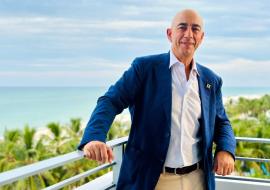Q & A with Felix JimenezTourism Minister of the Dominican Republic
by Jose Carlos de Santiago
The Dominican Republic’s travel industry has put pretty good numbers on the board in the first three quarters of the ongoing year, with growth nearly in the double digits from 2005.
The main efforts of this major Caribbean travel destination are now focused on raising the bar for the local tourism products and pouring far more money into the national infrastructure in a bid to branch out lodging on the one hand and clinching heftier revenues with cost-cutting policies on the other.
Q.- How have the inflows of foreign tourists been faring in the Dominican Republic?
A.- It’s been faring well. So far in 2006 –until the month of September- we’ve chalked up a 9.98 percent increase in the arrival of international tourists, with major standouts for Canada, with a whopping 22.14 percent and the U.S. with 9.33 percent. In the case of Europe, England has taken the cake. And I’m talking about the traditional outbound markets because those in Eastern Europe have ramped up dramatically, especially Poland that has dispatched 10,592 Polish tourists so far this year, compared to only 2,532 in the same span of time last year. The Russian market has also scored big this year with as many as 11,068 trekkers, compared to a meager 1,399 last year from January thru September. The same trend applies to Ukraine and other countries.
As far as traditional markets are concerned, England has posted a solid 17 percent spike, followed by Italy and Spain with 8.14 and 6.02 percent, respectively. Other markets, like Germany, have shrunk by 2 percent in the first nine months of this year.
Q.- What about revenues per tourists? Have they slowed down or just gotten better?
A.- The average daily spending has dwindled a tad. It used to be in the neighborhood of $110, and now it’s hovering around $102. However, overall revenues in the country continue on the rise. Last year, the Dominican Republic raked in $3.5 billion worth of earnings and we hope that figure could climb up to $3.8 billion this time around.
Q.- What do you make of the Spanish investors, like Bahia Principe, that’s opening half a dozen hotels in the Dominican Republic right now?
A.- The Piñeiro Group and Bahia Principe have made extraordinary investments, especially in the Samana region. They also have a fancy hotel in Punta Cana and, to the best of my understanding, they’ve got plans in the pipeline to start building a second hotel in that same area. They have invested heavily in Las Terrenas, with four deluxe hotels that must add up to 1,200 guestrooms. This is no doubt a tremendous investment effort that has helped raise the category of hotel rooms both in Samana and Las Terrenas.
However, the most important thing for me is the fact that there’re plenty of Spanish hotel chains out there willing to do business with the Dominican Republic, to negotiate and start operations in the country in the coming years.
Q.- Let’s go to the southern part of the country. We’re talking about Barahona, that province close to Haiti where Pedernales and Las Aguilas Beach are located, two of the poorest regions in the nation and perhaps the least known in terms of tourism. Nevertheless, they have potentials to step up development. What’s your government going to do to support that area?
A.- I’m just waiting for President Leonel Fernandez and the Minister of Environmental Protection to make a decision about the kind of development we’re going to embark on over there.
When I was flying from Santo Domingo to Madrid on Iberia, I was reading the Excelencias magazine, and there’s a very interesting article in it about El Hierro Island, the smallest of the Canary Islands and that was declared a World Biosphere Reserve by the United Nations. The point is that El Hierro now boasts hotels, great development, and there’s this Spanish guy, a bad Spanish person, I’d say, who’s been living in the Dominican Republic for quite some time. This Spanish guy makes a great fuss about everything related to the environment and he used to lash out at our efforts to develop Pedernales because he says it’s a World Biosphere Reserve, just as it one thing will have to be at odds with the other.
I believe the human race has made significant headway in terms of knowledge and expertise to know by now that we all need to develop a travel industry based on sustainable tourism, not only respectful of the environment, but also of our culture, our traditions, our people. We need to raise living standards in southwestern Dominican Republic and I’m convinced tourism is the key to generating that kind of development and slashing poverty.
Q.- Do local tourism authorities agree with that kind of development and do they chip in their own contribution to that particular project?
A.- Oh, absolutely. I think all authorities in both Pedernales and Barahona, as well as intellectuals, professionals and businesspeople are well aware of the need to spur tourism in those regions. That’s the only way out for both of them. Just remember we’re talking about two areas of the country with no good croplands, no mineral deposits underground. So, make no mistakes about it; tourism is the key to success in the two of them.
There’s some good news I want to break to you and it’s all about some negotiations with a group of Italian investors that’s willing to build and run a couple of hotels in Barahona. One of those lodgings will make the most of the mineral and thermal waters that spring up in a rural area called Canoa, pretty near the city of Barahona. The other one will be a beach hotel rigged out with a nautical club. Right now, there’re negotiations going on with the owners of those lands with good beach strips to try to cut a deal with them.














